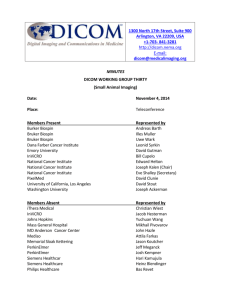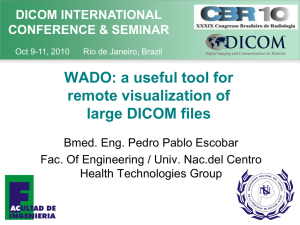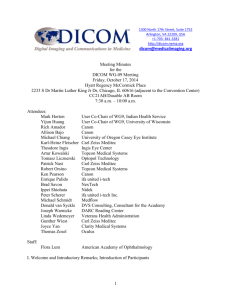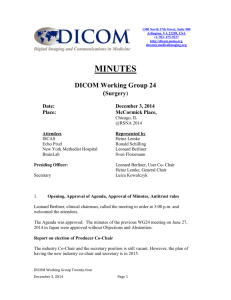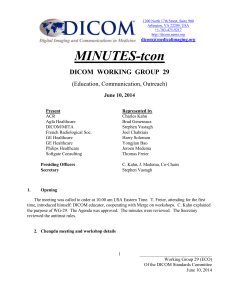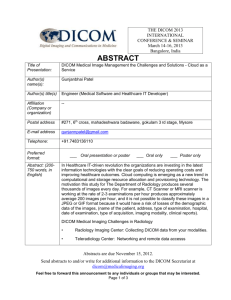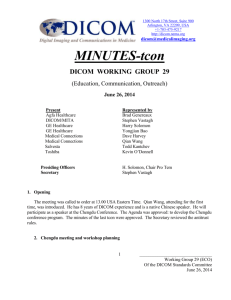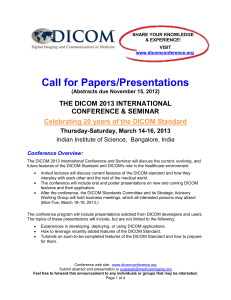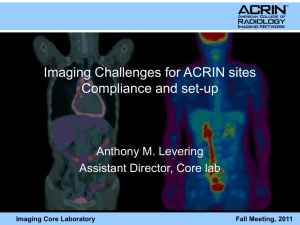WG-30-2014-03-26-Min-tcon - Dicom
advertisement
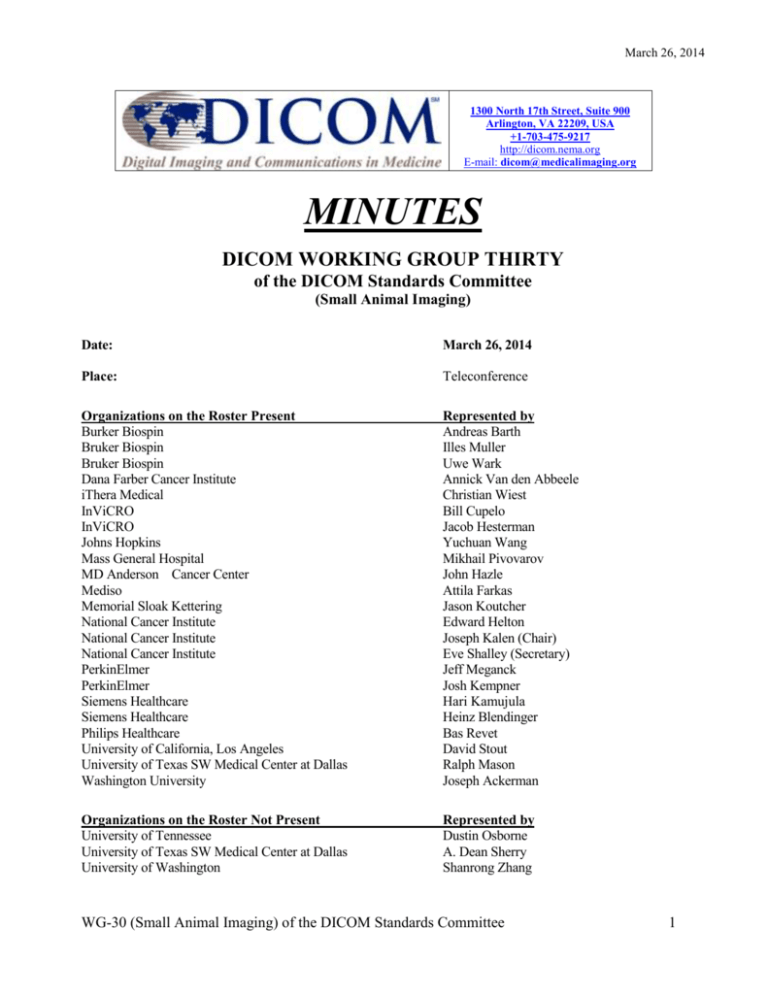
March 26, 2014 1300 North 17th Street, Suite 900 Arlington, VA 22209, USA +1-703-475-9217 http://dicom.nema.org E-mail: dicom@medicalimaging.org MINUTES DICOM WORKING GROUP THIRTY of the DICOM Standards Committee (Small Animal Imaging) Date: March 26, 2014 Place: Teleconference Organizations on the Roster Present Burker Biospin Bruker Biospin Bruker Biospin Dana Farber Cancer Institute iThera Medical InViCRO InViCRO Johns Hopkins Mass General Hospital MD Anderson Cancer Center Mediso Memorial Sloak Kettering National Cancer Institute National Cancer Institute National Cancer Institute PerkinElmer PerkinElmer Siemens Healthcare Siemens Healthcare Philips Healthcare University of California, Los Angeles University of Texas SW Medical Center at Dallas Washington University Represented by Andreas Barth Illes Muller Uwe Wark Annick Van den Abbeele Christian Wiest Bill Cupelo Jacob Hesterman Yuchuan Wang Mikhail Pivovarov John Hazle Attila Farkas Jason Koutcher Edward Helton Joseph Kalen (Chair) Eve Shalley (Secretary) Jeff Meganck Josh Kempner Hari Kamujula Heinz Blendinger Bas Revet David Stout Ralph Mason Joseph Ackerman Organizations on the Roster Not Present University of Tennessee University of Texas SW Medical Center at Dallas University of Washington Represented by Dustin Osborne A. Dean Sherry Shanrong Zhang WG-30 (Small Animal Imaging) of the DICOM Standards Committee 1 March 26, 2014 Others Present: Frederick National Laboratory / Leidos National Cancer Institute Ulli Wagner Stephanie Whitley Presiding Officer: Secretary: Joseph Kalen, Chair Eve Shalley 1. Opening The meeting was called to order at 10.00 on March 26. Members identified themselves, their employers, and their areas of interest. A quorum was present. Members reviewed the agenda and approved the discussion points. Ed Helton introduced the NCI Team and explained the origins of the DICOM WG 30 and its relationship to a broader effort at NCI to define informatics to support translational imaging research and co-clinical trials. The antitrust rules were reviewed Brief History and Overview of DICOM – David Clunie 2. David Clunie provided an overview of the origins of the DICOM standard in the mid-80’s and how it has evolved over the past 20 years to broaden its scope. He explained that he has been involved with DICOM for many years, and that he is involved with NCI projects due to his work as a radiologist on cancer trials. His function on the Working Group will be to support the effort to translate the contents needed for small animal imaging to DICOM, look for gaps, and provide information about what is already available and could be re-used by this group. Dr. Clunie and Ms. Shalley also reviewed the role of the Working Group members and some of the procedures established by NEMA that will be followed by the group. 3. Context and Needs, Project Priorities There was a discussion of what modalities the group should focus on, and which are the priorities, with sharing of data being the main issue and including information on the rodent model and rodent physiology. The following gaps and issues were raised by the group: In clinical practice there is only one subject, whereas in small animal imaging, you can have more than one. In Optical imaging you may have two to five animals at one time. DICOM standard as it currently is presented doesn’t speak to the notion of having more than one subject in front of the camera at once, and having metadata to track those animals would be useful. This issue also arose in WG 26 in relation to tissue microarrays that may have many specimens on one slide. How animals are housed and handled impacts the uptake of the molecular probe, and therefore animal physiological data should become part of a DICOM package. Concrete examples of important metrics include monitoring an animal’s temperature, heart rate, pulse oximetry, or respiration. These could be individual data points or waveforms (streaming data) - there are multiple pieces of synchronized equipment providing data. There is infrastructure in place to handle this for human subjects which could be adapted for small animal. Acquisition context can be encoded in an extensible manner so it is WG-30 (Small Animal Imaging) of the DICOM Standards Committee 2 March 26, 2014 easy to add more variables that may affect quality and practice. There is need to automate the mapping of a mouse atlas to a data set, to preserve the spatial information contained in data set. Another object in DICOM that could potentially be reused is segmentation object. The group will need to review what DICOM components could be used to satisfy this Use Case, and create a road map for what tools are needed to accomplish the goals in a standard way. Bruker is interested in creating an animal-specific coordinates system. This relates to the subject position in the machine, and also what kind of default orientation for imaging views (handing protocol) should be used in future. WG 25, the Veterinary Working Group, has created a new framework for orientation, which could be leveraged here. Another issue relates to how to organize hierarchies for coclinical trials, where there are multiple subjects and treatments (project, object, subject, etc.) There is a need to incorporate DCE-MR, spectroscopy and Chemical Shift Imaging (CSI) into the standard. There has been some work done on these standards, but they are not consistently implemented which creates a lot of manual effort for researchers. DICOM should be extended to in vivo microscopy. Since in vivo images not as large but there are many more of them, it is more like video than single frame imaging. It might be possible to reuse various objects and mix with multi-frame and video to produce a persistent form of in vivo microscopy. The need for histology and auto-radiography matching with PET or CT, and the fact that there is no auto-radiography object in DICOM, was also discussed. Instrument settings in optical imaging for small animals should be captured. This includes both planar and tomographic, and fluorescent microscopy and bioluminescent imaging. The communication between all imaging modalities is critical and optical is an area that requires a lot of work – quantitative information is quite different for modalities. One activity of the group can be to elucidate the Use Case and make it clear we need images and quantitative data on the same system, regardless of whether animal or human-derived. This helps to establish the gaps we need to fill in DICOM. The region-of-interest from one modality to the other varies, which causes quantitative issues. The quantitation aspect of the research is fundamental to the decision process, and adding some standards and the ability to go from one modality to the other is important. Members asked if others from their institutions could be enlisted to participate, especially those with specific expertise – translational expertise from clinical and pre-clinical. This is a good idea, since DICOM is fairly technical, and we’ll need that expertise to determine how mouse images will relate to human, and how to encode cross-references. 4. Working Group Planning The group agreed that a monthly meeting to keep the group apprised of activities and discuss any issues or topics of interest to the entire group. The day and time of the meeting will be determined based on input from the group. A face-to-face meeting is desirable, the date and time of which to be determined. We will likely break out into topic-specific sub-groups, but it is too early to determine what those will be at this point. WG-30 (Small Animal Imaging) of the DICOM Standards Committee 3 March 26, 2014 5. The group requested that David Clunie provide two educational sessions on DICOM – one basic and one more advanced – so that everyone has enough knowledge to participate effectively. The group agreed that engaging the Society of Nuclear Medicine and Molecular Imaging (SNMMI) and the International Society for Magnetic Resonance in Medicine (ISMRM), which are already working together on a pre-clinical training program. The World Molecular Imaging Congress (WMIS) was also suggested as a possible collaborator. New Business No new business. 6. Adjourn The meeting was adjourned at 12.00 on March, 26. 7. Action Items Item Set up training sessions (DICOM 101 and 301) Establish monthly meeting time Reach out to SNMMI and ISMRM Finish first draft of Strategy Document based on this discussion Distribute Minutes of the meeting If desired, send materials to David Clunie with which you are not satisfied as relates to DICOM compliance; he will run his validators against them Review existing DICOM objects for possible reuse by WG 30 Confirm interest in participating in WG 30; enter contact information into NEMA email listserv Provide NEMA listserv information to members Responsible Eve Shalley, David Clunie Eve Shalley David Stout David Clunie, Joseph Kalen Eve Shalley All vendors David Clunie All members Eve Shalley Submitted by: Eve Shalley, Secretary Reviewed by legal Counsel: Clark Silcox WG-30 (Small Animal Imaging) of the DICOM Standards Committee 4

